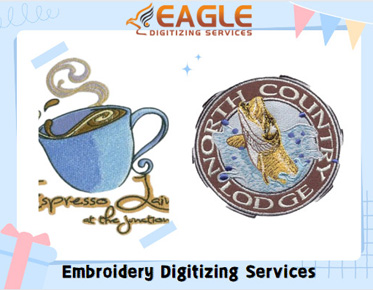Embroidery Digitizing 101: Top Mistakes to Avoid
Embarking on the journey of embroidery digitizing can be both thrilling and daunting. Have you ever wondered why some embroidery projects turn out flawless while others fall short of expectations? In this comprehensive guide, we'll delve into the top mistakes to avoid in embroidery digitizing, ensuring your projects are nothing short of spectacular.
Fabric
types and textures
Mastering embroidery digitizing begins with a profound understanding of various fabric types and textures. Different fabrics react uniquely to embroidery, necessitating tailored approaches for optimal results. Whether it's the delicate weave of satin or the rugged texture of denim, familiarity with fabric nuances is paramount for successful digitizing endeavors.
Limitations
of embroidery machines
Embroidery machines, while marvels of modern technology, possess inherent limitations that must be acknowledged and accommodated. Factors such as maximum stitch counts, color capabilities, and hoop sizes dictate the boundaries within which digitizing must operate. By grasping these constraints, embroiderers can tailor their designs to align seamlessly with machine capabilities, ensuring smooth execution and impeccable outcomes.
Choosing
the right software
Embroidery digitizing software serves as the cornerstone of the digitization process, offering a suite of tools and functionalities to bring designs to life. Selecting the appropriate software entails careful consideration of factors such as compatibility, user interface, and design versatility. Whether opting for industry stalwarts or niche innovators, choosing the right software lays the groundwork for successful digitization endeavors.
Learning
software features and functions
Mastery of digitizing software hinges on a thorough understanding of its features and functions. From intricate stitch editing tools to intuitive design management capabilities, delving into the intricacies of software enables embroiderers to unleash their creative potential and execute designs with precision. By investing time in software proficiency, embroiderers can navigate the digitizing landscape with confidence and finesse.
Importance
of proper scaling
Design scaling is a critical aspect of embroidery digitizing, influencing the visual integrity and structural stability of stitched designs. Proper scaling ensures that designs translate seamlessly from digital conception to physical manifestation, preserving intricate details and proportions with precision. Whether resizing for different garment sizes or adjusting design elements for aesthetic balance, meticulous attention to scaling is indispensable for impeccable results.
Effects
of incorrect scaling
Failure to adhere to proper scaling principles can yield detrimental effects on the quality of embroidered designs. Incorrect scaling may manifest as distorted proportions, pixelation, or loss of detail, detracting from the visual allure and professional finish of the embroidery. By prioritizing accurate scaling practices, embroiderers can uphold design integrity and deliver flawless outcomes that captivate and endure.
Understanding
stitch density
Stitch density serves as the cornerstone of embroidery quality, dictating the density of stitches per unit area and influencing the visual impact and tactile feel of embroidered designs. Whether aiming for intricate detail or robust coverage, mastering stitch density empowers embroiderers to achieve desired outcomes with precision and finesse. By discerning the nuances of stitch density, embroiderers can optimize design aesthetics and structural integrity, yielding results that delight and endure.
Effects
of incorrect stitch density
Deviation from optimal stitch density can precipitate a cascade of adverse effects, compromising the quality and durability of embroidered designs. Insufficient stitch density may result in sparse coverage and fabric show-through, while excessive density can lead to puckering, distortion, or thread breakage. By maintaining a delicate balance in stitch density, embroiderers can mitigate potential pitfalls and realize designs that exude sophistication and craftsmanship.
Importance
of underlay stitches
Underlay stitches serve as the unsung heroes of embroidery digitizing, laying the groundwork for impeccable stitch execution and fabric stability. These foundational stitches provide structural reinforcement and prevent fabric distortion, ensuring smooth and uniform stitching across the design. By incorporating strategic underlay stitches, embroiderers can fortify designs against the rigors of stitching and achieve flawless results that stand the test of time.
Types
of underlay stitches
Diverse underlay stitch techniques offer versatile solutions for addressing varying fabric characteristics and design complexities. From zigzag underlay for light fabrics to perpendicular underlay for intricate details, each stitch type serves a distinct purpose in optimizing design stability and stitch quality. By discerning the merits of different underlay techniques, embroiderers can tailor their approach to suit specific design requirements, unlocking the full potential of their craft and delivering superior results.
Importance
of simplicity
In the realm of embroidery digitizing, simplicity reigns supreme, with less often equating to more in terms of visual impact and stitch quality. Overcomplicating designs with excessive detail or overcrowded elements can overwhelm the viewer and compromise the legibility and aesthetic appeal of the embroidery. By embracing simplicity as a guiding principle, embroiderers can distill designs to their essence, allowing each element to shine with clarity and elegance.
Avoiding
overcrowded designs
Resisting the temptation to overcrowd designs requires a discerning eye and a commitment to restraint in design composition. By allowing ample breathing room for design elements and prioritizing clarity of form, embroiderers can optimize stitch quality and visual impact, fostering a harmonious balance between intricacy and simplicity. Whether embellishing garments or crafting heirloom pieces, embracing the art of restraint ensures that embroidered designs resonate with timeless elegance and enduring beauty.
Impact
of thread and needle choice
The selection of thread and needle exerts a profound influence on the quality, durability, and aesthetic appeal of embroidered designs. From vibrant hues to subtle sheens, thread selection imparts personality and character to embroidered creations, while needle choice determines stitch penetration and fabric interaction. By choosing threads and needles that harmonize with design intent and fabric characteristics, embroiderers can elevate their craft and imbue designs with a distinctive allure that captivates the senses.
Selecting
the appropriate thread and needle
Navigating the vast array of thread types and needle sizes demands a discerning eye and a nuanced understanding of their respective properties and applications. Whether opting for polyester for its vibrant colors or rayon for its lustrous sheen, thread selection hinges on factors such as fabric compatibility, design complexity, and desired aesthetics. Similarly, needle selection involves considerations of fabric weight, stitch density, and embroidery technique, with each needle type offering unique advantages in stitch formation and fabric interaction. By aligning thread and needle selection with design requirements and fabrication considerations, embroiderers can orchestrate a symphony of color and texture that transforms ordinary garments into extraordinary works of art.
Importance
of proper hooping
Proper hooping lays the foundation for successful embroidery, ensuring optimal fabric tension, alignment, and stability throughout the stitching process. From securing fabric edges to minimizing hoop marks, meticulous hooping techniques are indispensable for achieving crisp, clean embroidery that exudes professionalism and precision. By mastering the art of hooping, embroiderers can instill confidence in their craft and deliver results that surpass expectations.
Techniques
for proper hooping
Effective hooping entails a series of deliberate steps and adjustments to achieve the ideal fabric tension and alignment within the embroidery hoop. Whether employing hand-guided hooping or employing specialized hooping aids, embroiderers must strive for uniform tension and flatness across the fabric surface. Techniques such as floating stabilizers and strategic repositioning facilitate smooth and consistent stitching while minimizing distortions and fabric puckering. By honing their hooping proficiency and embracing innovative techniques, embroiderers can elevate the quality and professionalism of their work, ensuring that each embroidered creation is a testament to their skill and expertise.
Importance
of testing designs
Conducting thorough design tests is a crucial step in the embroidery digitizing process, allowing embroiderers to identify and rectify potential issues before commencing full-scale production. Whether evaluating stitch density, thread tension, or design alignment, testing enables embroiderers to fine-tune settings and parameters for optimal results. By investing time in comprehensive design testing, embroiderers can preempt costly errors and ensure that each embroidered creation meets exacting standards of quality and craftsmanship.
Conducting
test runs
Design testing encompasses a series of methodical tests and adjustments to assess stitch quality, color accuracy, and overall design integrity. From test stitching on sample fabrics to trial runs on production garments, each test serves as a valuable opportunity to refine and optimize design settings. By scrutinizing test results and iteratively adjusting parameters, embroiderers can pinpoint and resolve potential issues, ensuring that final embroideries exhibit flawless execution and precision. Whether validating design viability or fine-tuning stitch parameters, diligent testing lays the groundwork for successful embroidery production and customer satisfaction.
Planning
color changes
Strategic planning of color changes is essential for optimizing production efficiency and minimizing interruptions in the embroidery workflow. Whether sequencing colors for gradient effects or coordinating hues for multi-color designs, meticulous color planning streamlines production and enhances design continuity. By organizing color changes logically and preemptively, embroiderers can streamline workflow processes and maximize productivity without sacrificing design integrity or quality.
Minimizing
color change interruptions
Minimizing interruptions due to color changes requires proactive planning and efficient execution throughout the embroidery process. Techniques such as batch processing and thread management optimize production efficiency by reducing downtime associated with thread changes and minimizing thread waste. By implementing seamless color change strategies and leveraging technology for automated color sequencing, embroiderers can minimize production disruptions and realize substantial gains in productivity and workflow efficiency. Whether optimizing production throughput or enhancing design continuity, meticulous attention to color change management fosters a seamless embroidery workflow and ensures consistent, high-quality results that delight and impress.
Negative
consequences of rushing
Rushing through the digitizing process can compromise the quality, accuracy, and consistency of embroidered designs, resulting in subpar outcomes that fail to meet customer expectations. From overlooked design flaws to hasty parameter adjustments, rushing increases the likelihood of errors and undermines the integrity of the embroidery. By prioritizing quality over speed and adopting a methodical approach to digitizing, embroiderers can safeguard against costly mistakes and deliver embroidered creations that surpass expectations in craftsmanship and excellence.
Importance
of patience and attention to detail
Patience and attention to detail are paramount virtues in embroidery digitizing, underpinning a meticulous approach to design execution and quality assurance. Whether refining stitch parameters or fine-tuning design elements, patience enables embroiderers to iterate and optimize settings for optimal results. Similarly, attention to detail ensures thorough scrutiny of design integrity, stitch quality, and production consistency, safeguarding against oversights and errors that compromise embroidery quality. By embracing patience and diligence as guiding principles, embroiderers can uphold standards of excellence and deliver embroidered creations that captivate and endure.
Embroidery digitizing is a multifaceted discipline that demands precision, creativity, and technical expertise to achieve superior results. By avoiding common pitfalls and embracing best practices in digitizing, embroiderers can elevate their craft and unlock the full potential of their creativity. Whether honing software proficiency, mastering stitch techniques, or refining design aesthetics, each aspect of digitizing contributes to the overall quality and impact of embroidered creations. By navigating the intricacies of digitizing with skill and finesse, embroiderers can create embroidered masterpieces that inspire admiration, evoke emotion, and stand the test of time.
Are you ready to elevate your embroidery game?
If you're seeking professional embroidery digitizing services, look no further
than Eagle
Digitizing. With a team of skilled digitizers and a commitment to
quality, Eagle Digitizing ensures that your embroidery visions come to life
with precision and perfection. Contact us today to bring your designs to the
next level!


